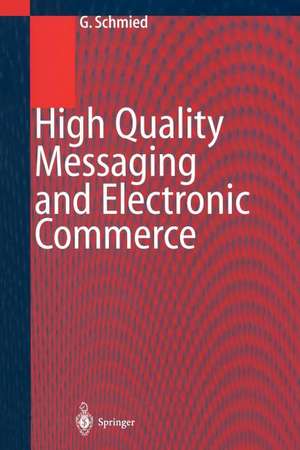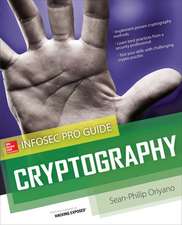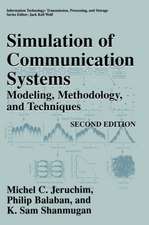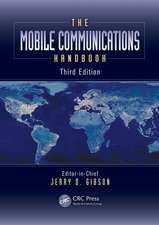High Quality Messaging and Electronic Commerce: Technical Foundations, Standards and Protocols
Autor Gerhard Schmieden Limba Engleză Paperback – 18 sep 2011
Preț: 383.33 lei
Nou
Puncte Express: 575
Preț estimativ în valută:
73.36€ • 76.31$ • 60.56£
73.36€ • 76.31$ • 60.56£
Carte tipărită la comandă
Livrare economică 15-29 aprilie
Preluare comenzi: 021 569.72.76
Specificații
ISBN-13: 9783642641831
ISBN-10: 3642641830
Pagini: 212
Ilustrații: XX, 184 p.
Dimensiuni: 155 x 235 x 11 mm
Greutate: 0.3 kg
Ediția:Softcover reprint of the original 1st ed. 1999
Editura: Springer Berlin, Heidelberg
Colecția Springer
Locul publicării:Berlin, Heidelberg, Germany
ISBN-10: 3642641830
Pagini: 212
Ilustrații: XX, 184 p.
Dimensiuni: 155 x 235 x 11 mm
Greutate: 0.3 kg
Ediția:Softcover reprint of the original 1st ed. 1999
Editura: Springer Berlin, Heidelberg
Colecția Springer
Locul publicării:Berlin, Heidelberg, Germany
Public țintă
Professional/practitionerCuprins
1 Introduction.- 2 The X.400 Series of Recommendations.- 2.1 The X.400 Standard 1984.- 2.2 The X.400 Standard 1988.- 2.3 The X.400 Standard 1992.- 2.4 The X.400 Standard 1996.- 2.5 Proposed Additions to the X.400 Functionality for Multimedia Messaging.- 2.6 Physical Access to the X.400 Service.- 3 Internet Mail.- 3.1 RFC 822: Standard for the Format of ARPA Internet Text Messages.- 3.2 RFC 821 Simple Mail Transfer Protocol.- 3.3 SMTP Service Extensions.- 3.4 Delivery Status Notifications (DSN).- 3.5 Multipurpose Internet Mail Extensions (MIME).- 3.6 Post Office Protocol Version 3 (POP3).- 4 X.400-internet Mail Gateways.- 4.1 Introduction.- 4.2 MIME Internet X.400 Enhanced Relay (MIXER).- 5 Directory Services.- 5.1 The X.500 Series of Recommendations.- 5.2 Lightweight Directory Access Protocol (LDAP).- 6 Electronic Commerce and Electronic Data Interchange.- 6.1 The History of Electronic Commerce.- 6.2 Electronic Commerce Today.- 6.3 Electronic Data Interchange—An Introduction.- 7 Standards for EDI Documents.- 7.1 United Nations Electronic Data Interchange for Administration, Commerce and Trade (UN/EDIFACT).- 7.2 Differences and Mutualities Amongst the Different EDI Standards.- 8 Transportation of EDI Messages.- 8.1 EDI Message Transfer via Store-and-Forward Mechanisms.- 8.2 EDI Message Transfer via X.400.- 9 Vulnerabilities and Security Requirements of EDI Messaging Environments.- 9.1 Vulnerabilities.- 9.2 Masquerade.- 9.3 Message Sequencing.- 9.4 Message Loss.- 9.5 Modification of Information.- 9.6 Repudiation.- 9.7 Leakage of Information.- 9.8 Manipulation of Information by EDIMG User.- 9.9 Security Requirements.- 10 Cryptography and Key Management.- 10.1 Cryptography.- 10.2 Key Management.- 11 Security Mechanisms for EDI over X.400.- 11.1 Masquerade.- 11.2 MessageSequencing.- 11.3 Message Loss.- 11.4 Modification of Information.- 11.5 Repudiation.- 11.6 Leakage of Information.- 11.7 Manipulation of Information by EDIMG User.- 11.8 Additional Pervasive Mechanisms.- 12 Security Mechanisms for EDI over the Internet.- 12.1 E-Mail Encryption Protocols.- 13 EDI Naming, Addressing, and Use of a Directory.- 13.1 Introduction.- 13.2 EDI Naming.- 13.3 Suggested DIT Structure for EDI.- 13.4 Name Resolution.- 13.5 Authentication.- 13.6 Capabilities Assessment.
Textul de pe ultima copertă
This is a technical guide to standards and protocols like X.400 and SMTP for personal electronic mail and electronic commerce based on electronic data interchange (EDI). Security aspects are extensively treated. Part of the book includes results of a project of the European Commission (NOPROBLEMS).
Caracteristici
Describes comprehensively the protocols, the system management, electronic data interchange (EDI), the security mechanisms and the state of the art of an e-commerce and messaging platform












